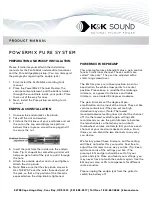
Tankside Monitor NRF81
Commissioning
Hauser
69
9.2.9
Tank calculation: Hydrostatic tank gauging (HTG)
Hydrostatic Tank Gauging (HTG) is a method to calculate the level and the density of the
product inside a tank using pressure measurements only. The pressure is measured at
different heights of the tank using one, two or three pressure sensors. With these data the
density or the level of the product (or both) can be calculated.
Overview of the HTG parameters
H
P1
H
P1-P2
g
P1
P2
P3
L
HTG
H
P3
ρ
P
ρ
V
ρ
A
A0028711
32
HTG parameters
Parameter
Navigation path
P1 (Bottom pressure)
Setup → Advanced setup → Application → Tank configuration → Pressure → P1 (bottom)
H
P1
(Position of P1 sensor)
Setup → Advanced setup → Application → Tank configuration → Pressure → P1 position
P2 (Middle pressure)
Setup → Advanced setup → Application → Tank configuration → Pressure → P2 (middle)
H
P1-P2
(Distance between P1 and P2 sensors)
Setup → Advanced setup → Application → Tank configuration → Pressure → P1-2 distance
P3 (Top pressure)
Setup → Advanced setup → Application → Tank configuration → Pressure → P3 (top)
H
P3
(Position of P3 sensor)
Setup → Advanced setup → Application → Tank configuration → Pressure → P3 position
ρ
P
(Density of the product
• Read-only: Setup → Advanced setup → Application → Tank calculation → HTG → Density value
• Writable: Setup → Advanced setup → Application → Tank calculation → HTG → Manual density
ρ
V
(Vapor density)
Setup → Advanced setup → Application → Tank configuration → Density → Vapor density
ρ
A
(Ambient air temperature)
Setup → Advanced setup → Application → Tank configuration → Density → Air density
g (Local gravity)
Expert → Application → Tank Calculation → Local gravity
L
HTG
(Calculated level)
Setup → Advanced setup → Application → Tank calculation → HTG → Tank level
1)
Depending on the
HTG mode
parameter this is a writable or a read-only parameter.
















































